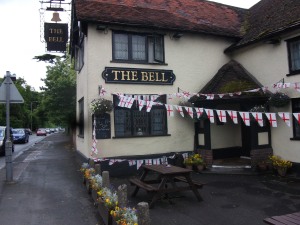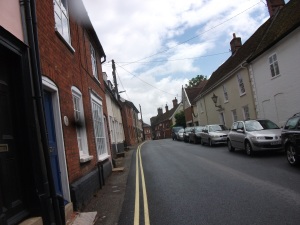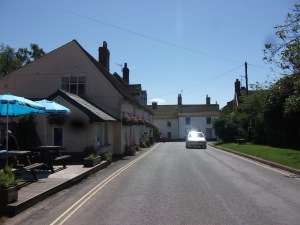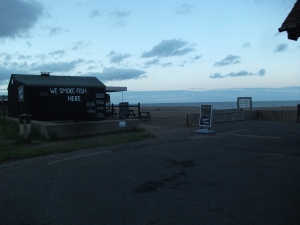“Just let nature get on with it” – Darren, Holbrook.
Today is horrible and wonderful. Just imagine spending many hours travelling through a painting by John Constable, matched with torrential rain. That’s been my day, a combination of gruelling, wondrous and inspiring. It’s an unlikely combination that can only reflect the unlikely moods of the Suffolk weather, which today passed from blissful sun to torrential rain to something in between.
Today’s also when my digital camera acquires a second spot, and my bike pannier acquires a large hole. I give it 3 days before all my equipment dies.
The question giving me a headache today is whether history determines who we are.
I mean it on a personal level initially. Do you often ever regard your personality traits, or life decisions, as the inevitable and pre-determined effects of experiences in earlier life? Or worse, do you sometimes allow yourself to think that the faults inherited from parents or grandparents will naturally play out in your life? I think at certain points we do, or many of us do. We confuse the sum of those experiences with a separate overarching story that we tell ourselves, about why this thing happened and not that.
Spinoza has a great line. He says: ‘Citizens are not born, but made’. I often think about this, about how forms of education, urban building, transport, media stuff, and the rest, drive us into adopting certain attitudes, pleasures, and ways of life.
I’ve been wondering about all this history I’ve been encountering in the last few days. At school, ‘History’ was the Tudors and ancient Greeks, then later, an exhaustive study of the two world wars of the 20th century. Dunkirk and the Battle of Britain are the history taught, and so no doubt get reflected on all the time in terms of pride and proudest moments. But so much of the histories I’ve been encountering, of successive waves of Romans, Vikings and Saxons, not to mention the ecological and archaeological histories I want to tap into, are all missing. In fact, after today, it gets older and weirder.
War, war, and more war, that’s what they taught us. I don’t say it complacently. I have a degree and an A-level in it. Ask me what gunboat diplomacy or Suez mean and I can bore you for five minutes. But no, there’s more there to these isles than that kind of myopic and aggressive history.
So one kind of history determines a view of a self-important international place through military fighting, and another might direct us towards something more different, more open-minded, egalitarian, relativist and democratic. But let me narrate the landscape.
I awake in a comfy bed in Holbrook, by the Royal Hospital School, a huge navy medical training academy for 11 to 18 year olds built in the 1930s. It’s an unlikely interruption to the landscape, with its looming church tower and random structures. I am surrounded by the superb and ethereal photography of Sue, and given breakfast and good conversation by Darren.
He is a mine of wonderful ecological information that you’ll find interesting. He tells me of the eroding Suffolk coast, where Shark teeth have been found where the rocks have collapsed, of sizes unknown in contemporary species. You can walk on the beaches and collect them wherever some cliff rock has fallen. On this Essex/Suffolk coastline, erosion is a regular and historic feature. Huge amounts of money are spent building defences for land which is already under sea-level. Can we fight nature? I’m persuaded that we can’t. I hear of an excellent move to pull down flood walls and create salt marshes which in turn reduce floods. I’m persuaded by the idea of working with nature, and its natural climate swings, land-and-sea tugs of war, and overall fluctuations that define its moody history.
The local landscape is full of mysteries. Nearby is Alton Water, full of the most extraordinary life. Further away is Foulness Island, a place that no member of the public is allowed to visit as the MOD owns the land, yet still a community of civilians lives there. Darren describes visiting there, a place like the 1950s, where one cannot bring a camera. Essex is extraordinary, a place with more contrasts and quirks than few of us would believe. A worthy book ought to be written mapping out these myths.
It seems our approach to natural problems is out of kilter with nature itself. Darren tells me of his recent work with ‘Operation Jab’, in response to the problem of badgers infecting cattle with bovine TB. Against all reliable scientific advice, an idiot named Owen Paterson insisted on culling badgers with guns. The result was to barely reduce the number of badgers and disperse many more into uninfected areas. I hear of a more reasonable project, that through careful observation and stewardship locates badger sets and vaccinates badgers over the course of some years. Eventually herd immunity to TB is established, and the disease cannot be communicated to cattle. It seems to work. Unfortunately with the current government, reason has as much currency today as mesolithic shark teeth. But then when have humans been reasonably governed?
From Holbrook I pass the pretty Orwell river to my right, and circle in to Ipswich, an incongruous and unlovely place. As I circle into the town, I pass dilapidated schools and community centres next to half-built high-rises, corporate blocks clad in playskool colours. Disused churches jut against a repetition of premier express offies and threads of small suburban houses. Bungalowland. I want to stay and get down to the mystery of places like Ipswich, like Basildon, places that indicate a common pattern of English life today, but I have little time, and follow the roads out eastwards.
Following a busy A road out, I first pass Sutton Hoo which, like any essential monument to our cultural roots, is surrounded by a motorway. Here, alongside Happisburgh and Cromer in Norfolk, evidence has been found that indicates that humans have been living on these islands for 900 000 years. Successive waves of varying species of humans have arrived here and attempted to stake out an existence, hunting with flint stones and living in small communities. Us, homo sapiens, have probably been here for only around 12, 500 years, and we’re defined by our larger social networks, our capacity for imagination, and our technological ingenuity (though genetic evidence reveals we loved Neanderthals too). These qualities should be lauded, and if you think laterally, there’s countless evidence for them still, in the tattoos, pub chat, old churches and entertainment devices that define everyday life of the places I pass through.
I pass through Woodbridge, a very pretty market town. There is a farmer’s market running, and the frequency of fancy baby clothing shops indicates that this is a high-mortgage area, like East Dulwich and Clapham in south London. I enjoy the ride, and again am sorry to leave. I can imagine alternative realities here, paths that live could have taken one along, as one often does, where one might regularly come here for awkward family Sunday dinners where there is little anyone wants to say, or a reunion of school mates ten years on, comparing contrasting paths into parenthood or ambitious city jobs. My intention’s a little barbed here. I’m coming across a standard of life and a social class that seems pretty unfamiliar. And yet with my posh voice and polite manners, I’m considered one of them.
“Your whole life, pretending to be someone you’re not” – man in Mill Inn pub, Aldeburgh.
I pass through some extraordinary countryside, passing pretty farms selling local asparagus and fresh manure. You can smell it, and it is strangely liberating. After the little town of Melton it’s pure forests and I’m in heaven, drifting through Rendelsham forest with its warnings of frogs and deer, and south later to Orford Ness, the place I’d struggled so hard yesterday to get to (the National Trust only open it on Saturdays from 10-2). The village here is traditional looking and pleasant, and I follow the path to the harbour, where after conversing with a wonderful if maamish National Trust volunteer, book my place on a ferry to Orford Ness.
If you have a month to live, put aside time to see this place. It is extraordinary.
The sea becomes one with the sky. I see this at St. Cedd, and later I see it here. The landscape is continually losing a war with the sea. Harbours at Orford and Dunwich have been lost to silt and erosion. Arriving onto Orford Ness by boat, one feels like one is entering another world, separated from this one by the lack of time and sound. It is remote and particularly cold. This is a former MOD site, used during the first world war for airfields. Later, among the unlikely scattered huts here, a small crew carried out the experimental procedures from 1935 that would later become radar, developed later in nearby Bawdsey Manor.
If we must talk war, then this technology above anything else ensured that the British survived during 1940-43 against a militarily-superior opponent. It was technological innovation, like here, and like Turing’s code-breaking at Bletchley, all feats of unpopular and highly intellectual scientific research, that saved the country from invasion, and less so the naivety of any invading army in 1940, or 1944, by which time the war had been won by the Russians. From 1949 until 1971 though, the place was used for top-secret government experiments with ballistic missiles. Up to 600 people lived behind river and barbed wire fence, testing detonation devices of atomic bombs on this isolated outcrop of shingle and mud.
It is an unusual place, a little like Dungenness, if any one place in the world can be like that. As I looked out from the bomb ballistics building at the Orford shingle, signs of its unusual sea pea and campion starting to flourish, I feel that I am gazing out at another world. The white shingle looks like fragments of bone, with small and beautiful flowers in between – evidence that life is miraculous, that life can flourish and grow even in the most dire or inhospitable of circumstances. There is little sound here, and time seems to have been suspended around 1965. What is presented is a kind of alternative reality, where the nuclear apocalypse did happen and the human race was terminated. In its place are the strange cries of the barn owls that have nested in the bomb control centre, and the extraordinary butterflies and songbirds that flit across one’s view across the shingle paths, spattered with metallic fragments.
I hear of one person’s encounter with Orford locals during this time. They refused to even speak of what happened on the other island. This place is such a wondrous secret, and I have to thank Mark Fisher’s recent Ghosts of My Life, and whose descriptions of the Suffolk landscape in the work’s final pages inspired me to visit here.
In the distance are a variety of Maunsell forts, where pirate radio once began life, broadcasting from these offshore rigs. Wilson’s paranoid 1966-70 Labour government once tried to jam the airwaves of Radio Caroline here. One of these today, HM Fort Roughs, is an independent sovereign state, called the Principality of Sealand. It is unofficially the world’s smallest country, being little more than old rig in the sea.
This is why England fascinates me! Consider this: Paddy Roy Bates, a bizarre man, seized the old WW2 defence rig in 1967 from some pirate radio broadcasters, and, with his family, set up an independent state with its own constitution. The family took on royal status, and today the island has, surely impossibly, its own football team. My god. Like Eel Pie island, how I love these things, these eccentricities that reproduce all the paradoxes and irreverence that form a counter-code of English defiance.
A volunteer explains to me the beauty of the place, and tells me how to spot Sealand. She explains how a sea chart works, where everything is upside-down, south precedes north, and the sea is divided into a vast map with unusual place names, like ‘The Wallet’, a stretch that surrounds Orford. A retired school teacher working across south London, she tells me of her husband lost at sea, single-handed sailing like John yesterday. The sea appears so tranquil in places like this, but it’s something humanity can never master. The coast here is marked with countless disasters and sunken ships, those lost in the great tragic storm of 1627, or any other time. Nature is master, always has been. Later, I’ll write to you about climate change and our ecological history. The story will be worth telling.
As I wander back, I touch two unexploded bombs, getting an illicit, boyish thrill. I’m full of glee. By the time I get off the island, it’s the late afternoon and I’m famished. Three kitkats disappear down my gullet, then from nowhere torrential rain appears. I struggle and die on the way to Aldeburgh, cursing into the rain. It’s an out of body experience, my body becoming like a set of piston movements while my brain determines to find a good pub. I avoid taking photos, concentrating just on staying alive. I pass another cyclist in the torrential rain and give him a thumbs up. Thinking about his laughter keeps me going the remaining miles.
One hour later, drenched beyond any point of comparison, I arrive in the sleepy seaside town. I find refuge in the Mill Inn and attempt to dry out. It’s an Adnams pub, the local brewery, and the beer does not disappoint, particularly the lager, which is rarely available outside the area. The town is curious too, with some charming old buildings next to the coast. It still retains and uses a quaint old moot hall by the sea, an ancient form of democratic assembly. It has some important feminist history too. It is the birthplace of Elizabeth Garrett Anderson, the first female to qualify as a surgeon and doctor in Britain and, later, the first female to be appointed mayor and magistrate for this town. Today, over a third of the properties are second homes, owned largely by wealthy Londoners, most of whom seem to have congregated to the pub tonight.
But, I am soaked to the skin. After three pints over three hours, I am still wet. I decide to put it down to a vote. The barman suggests I cycle up the road a few miles and set up camp (“it’ll be an adventure”). An old guy chuckles and says “stay here!” So I ask the most sensible person I know, Sarah, and she suggests a local hostel I’ve found. It’s a wise deciding vote.
I pedal my freezing and soaked body back up towards Snape, a town I passed in the heavy rain towards Aldeburgh, and over to Blaxhall. I’m beaten.
Yes, I should have bought a fancy lightweight bike that wouldn’t break down all the time. Yes, I should’ve spent more than the bare minimum on a tent and sleeping bag that wouldn’t disintegrate after light wear. And yes, I should have bought large expensive bike panniers that could carry all my gear plus the kitchen sink. Believe me, I know.
But my point is that anyone can cycle without going to excessive expense, and that cycling can be a pastime for anyone with little money. I may be suffering, but in this suffering I feel alive. The Suffolk dusk is bewitching. I pass fields where rabbits dart about, and more wondrous birdsong as the full sun is eclipsed by looming heavy rain clouds. I reach the youth hostel in Blaxhall and manage to resist hugging the manager.
I’m now in the warm, and full of pittas with grated cheese and premixed beans, sipping Jura scotch. It’s the end of day 4, and I decide on the first rule of my journey:
1. No cycling in the rain.
That will slow me down, but after today, I refuse to do it. I don’t have enough clothes. On the upside, it will mean getting stuck in curious places where, with some lurking and inquisitive questions, treasures might be found.
Tomorrow, I’m not sure how far I’ll get. Outside the cities, internet and phone coverage is poor. I have no way of telling, but my goal is Wymondham, Norfolk. Let’s see. Once again, wish me luck.












































Get this man a tv show
ps. hope your bike is alright!
The Royal Hospital School is just that, a school. It isn’t “a huge navy medical training academy for 11 to 18 year olds” It was built in the 1930s though, and the Greenwich Hospital School was relocated out into the country. It used to be for sons of seafarers, but is now an independent school for boys and girls.